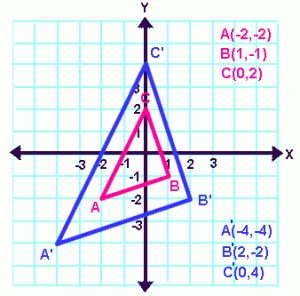Blog #19
“Rigid transformation”
This past week we have been learning about translation, rotation, and reflection. To translate you can either go to the left or to the right a certain number of spaces or up or down a certain number of spaces. For rotation you can either turn 90 degrees, 180 degrees, 270 degrees, or 360 degrees clockwise or counterclockwise. For reflection you can either be the same amount of spaces away from the x-axis, on the opposite side or the same amount of spaces away from the y-axis, on the opposite side also.
Blog #20
“Dilation”
In lesson 6.2.1 we learned about dilation. Dilation is when you multiply the coordinates by a number that’ll enlarge the shape or you can divide it and shrink the size of the shape. If some of the numbers you are multiplying or dividing by are extremely big and the rest are extremely small then it could cause the angles to change the size of the shape.
Blog #21
“Finding similar shapes”
Today in class we elaborated more on what determined whether a shape was similar or not. We were able to decide which shapes were similar by looking at their scaled factor. A scale factor is the number that is multiplied or divided by all the points in the shape, resulting in dilating the shape.
Blog #22
Today in class we focused on how to find a missing side. In order to do this we had to have 2 similar shapes. Then take the side of the original shape and divide it by the new number or variable. After doing this you would get the scale factor and be able to find the unknown side lengths of the shape.





Leave a Reply